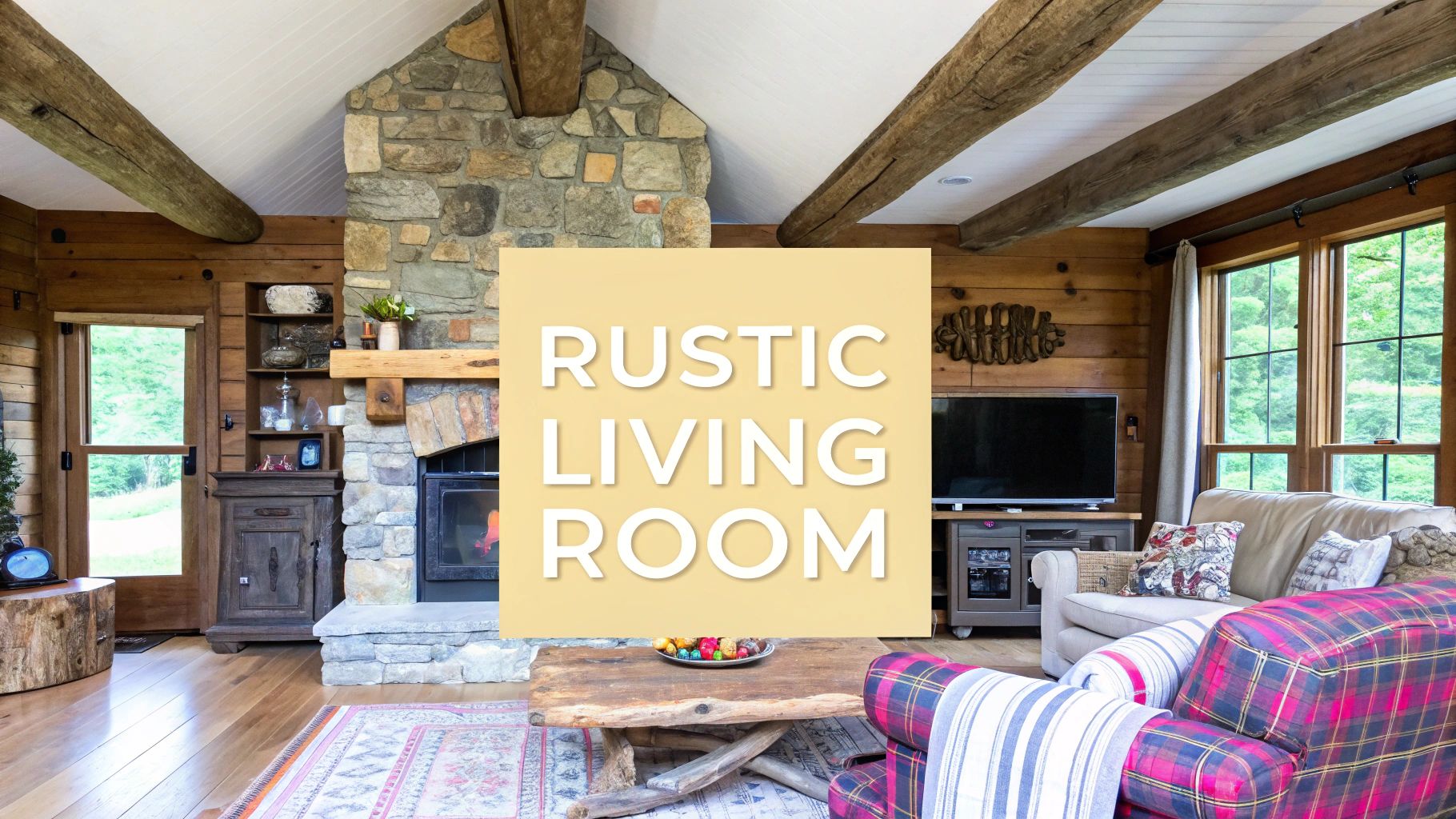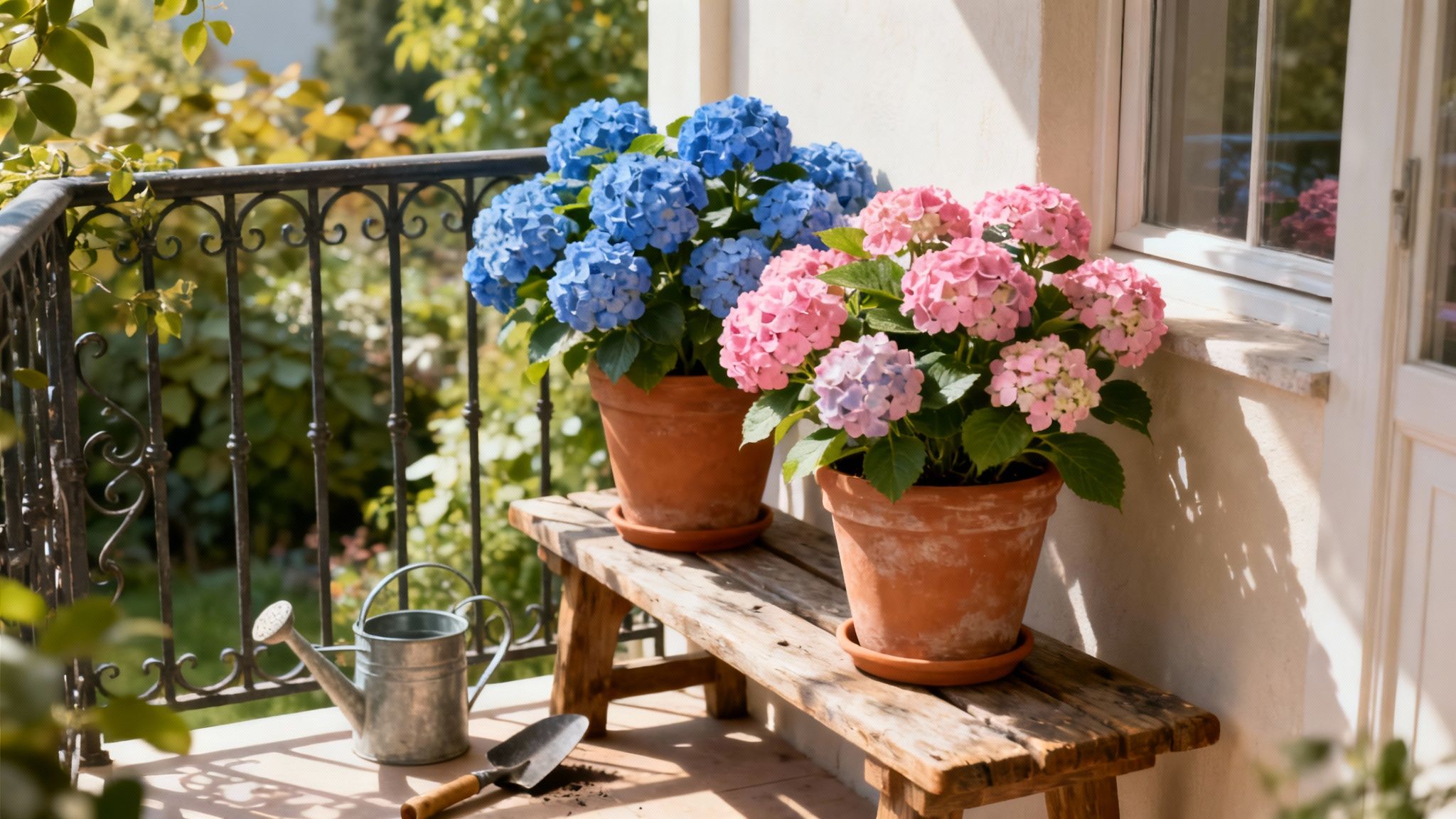The rustic living room is more than a design trend; it's a celebration of natural materials, cosy textures, and timeless character. It invites you to slow down, get comfortable, and connect with the raw beauty of the outdoors from the comfort of your home. This style masterfully blends rugged elements with soft comforts, creating a space that feels both grounded and inviting. From the architectural statement of exposed beams to the subtle warmth of layered textiles, achieving this look is about curating a collection of pieces that tell a story.
In this comprehensive guide, we move beyond generic advice to explore nine distinct yet complementary ideas. We will help you design a rustic living room that is authentic, stylish, and uniquely yours. Prepare to discover actionable insights and practical implementation tips for every element, including:
- Creating a focal point with reclaimed wood or stone.
- Integrating vintage furniture with modern comforts.
- Mastering the art of layering natural fabrics and patterns.
- Selecting the perfect industrial and antique-style accents.
We will provide the specific details needed to transform your space into a sanctuary of rustic elegance, ensuring every choice contributes to a cohesive and inspiring whole.
1. Reclaimed Wood Accent Walls
A reclaimed wood accent wall is a definitive way to introduce authentic character and warmth into your rustic living room. This design feature involves using salvaged wood planks, often from old barns, factories, or other dismantled structures, to cover an entire wall or a section of it. The inherent imperfections, such as nail holes, weathering, and a rich patina, tell a story and create a powerful visual focal point that immediately grounds the space in rustic charm.

This approach is highly versatile, suiting everything from modern farmhouse aesthetics popularised by designers like Chip and Joanna Gaines to more traditional mountain cabin retreats. An accent wall behind a media centre or a fireplace can anchor the room's layout, providing a textured backdrop that enhances the entire design scheme.
How to Implement a Reclaimed Wood Wall
Creating a successful accent wall requires careful planning. You can source genuine reclaimed timber or use high-quality replica products for an easier installation.
- Preparation is Key: Before installation, ensure the wall is clean, dry, and flat. It's also crucial to install a proper moisture barrier, especially on exterior walls, to protect both the wood and your home's structure.
- Safety First: Lightly sand the planks to remove any potential splinters but be careful not to erase the wood's aged character. Sealing the wood with a matte or satin polyurethane finish will protect it from dust and moisture without adding an artificial-looking gloss.
- Strategic Placement: Consider a partial wall, such as a horizontal band or a fireplace surround, if a full wall feels too overpowering for your space. This adds texture without making the room feel smaller or darker.
- Enhance with Lighting: Use track lighting or wall-mounted sconces to graze the surface of the wood. This technique highlights the unique textures and tonal variations, creating dramatic shadows and depth.
2. Stone Fireplace Surrounds
A natural stone fireplace surround is a quintessential element of the rustic living room, serving as a dramatic and enduring focal point. This design feature utilises materials like fieldstone, river rock, or slate to encase the fireplace, grounding the room with immense texture and an earthy, organic appeal. From the grand fieldstone hearths of Adirondack lodges to the smooth river rock surrounds found in Pacific Northwest homes, a stone fireplace provides both physical warmth and powerful visual weight.
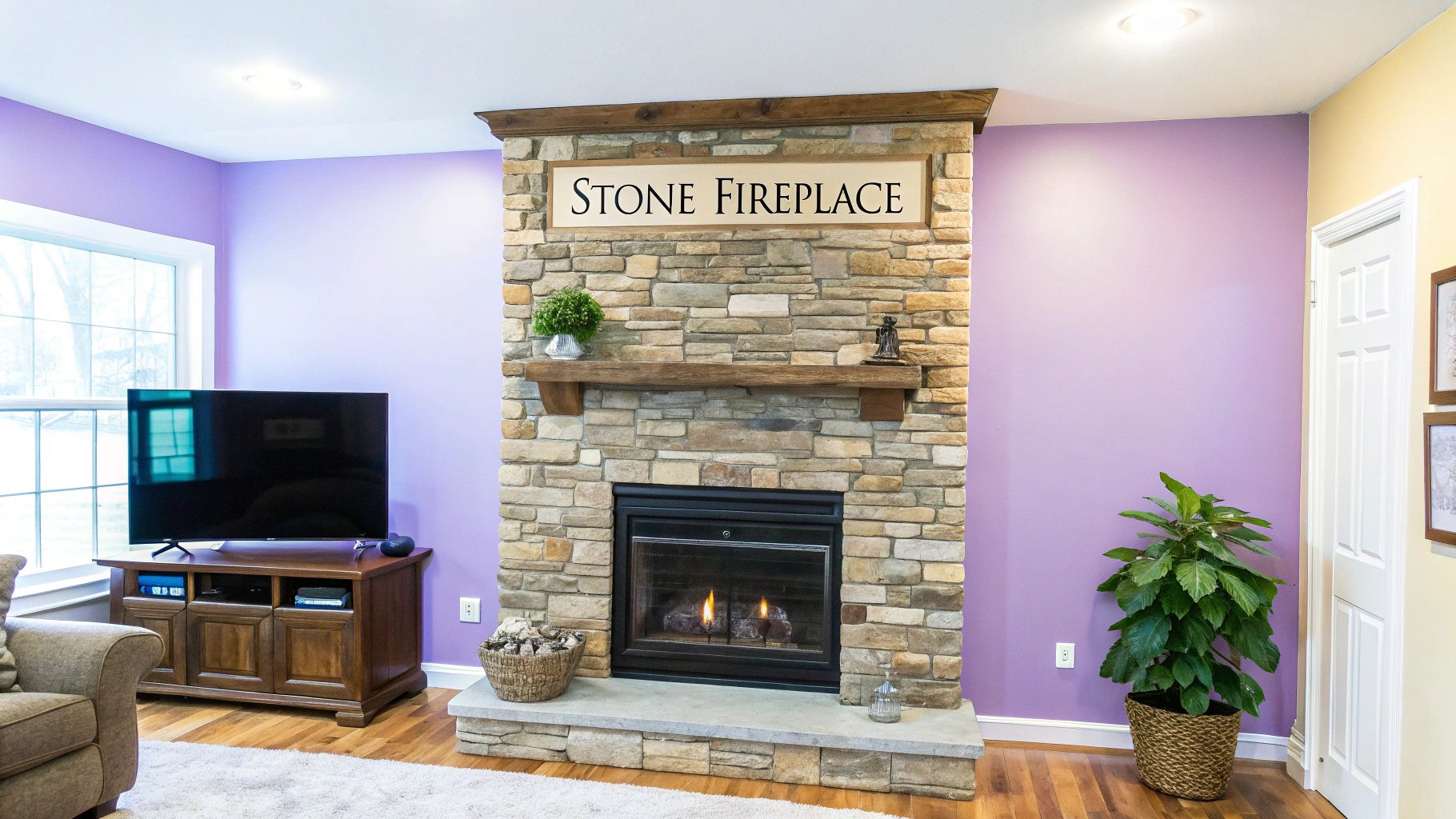
This classic centrepiece instantly establishes an atmosphere of permanence and connection to the outdoors. Whether you opt for genuine stone or a high-quality manufactured veneer from brands like Cultured Stone, the result is a timeless feature that anchors your furniture arrangement and enhances the cosy, sheltered feeling that defines rustic interior design.
How to Implement a Stone Fireplace Surround
Choosing and installing a stone surround requires careful consideration of scale, material, and finishing touches to ensure it complements your space.
- Select Appropriate Stone: Choose stone that reflects your home’s architectural style or local geology. For example, limestone suits Texas hill country aesthetics, while rugged slate or granite fits a mountain cabin vibe. Consider using manufactured stone veneer for a lighter, more cost-effective option.
- Balance Scale and Proportion: The size of the fireplace surround should be proportional to the room. A massive, floor-to-ceiling installation can overpower a small room, while a modest surround might get lost in a great room with vaulted ceilings.
- Add a Wooden Mantel: Contrast the cool, rugged texture of the stone with a warm, chunky wooden mantel. A reclaimed beam or a simple, rustic plank provides a perfect surface for displaying décor and breaks up the stone's visual mass.
- Highlight with Lighting: Install recessed downlights or directional spotlights in the ceiling above the fireplace. This will cast light down the face of the stone, creating shadows that accentuate its natural texture and colour variations.
- Protect and Maintain: Apply a quality penetrating sealer to natural stone, especially porous types like sandstone or limestone. This helps prevent soot stains and makes cleaning much easier without altering the stone's natural appearance.
3. Exposed Wooden Beams
Exposed wooden beams, whether structural or purely decorative, are a hallmark of rustic design, adding architectural gravitas and a sense of history to a living room. Drawing the eye upward, they create an impression of height and space while infusing the room with organic texture and warmth. These elements are fundamental to creating an authentic rustic living room, providing a framework that feels both grand and inviting.
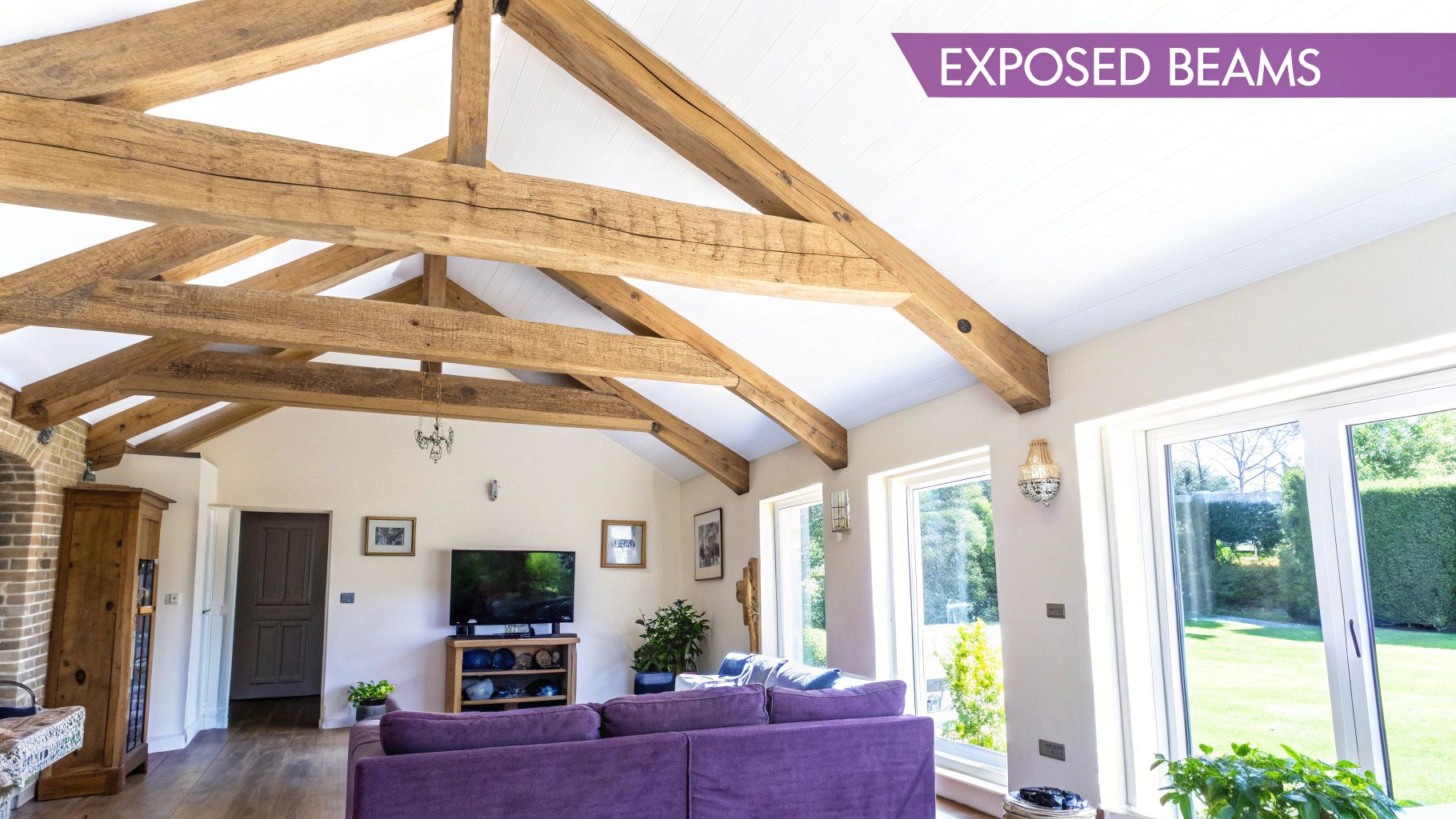
This feature is incredibly versatile, seen in everything from historic timber-frame homes with hand-hewn chestnut beams to modern farmhouse interiors that use reclaimed barn wood. Beams can define the character of a room, serving as a powerful visual anchor that complements other rustic elements like stone fireplaces and natural textiles. They provide an overhead layer of detail that makes the entire space feel cohesive and thoughtfully designed.
How to Implement Exposed Wooden Beams
Integrating beams successfully requires attention to proportion, material, and placement. You can expose existing structural joists, add genuine reclaimed beams, or opt for lightweight faux wood alternatives.
- Mind the Proportions: Carefully consider the spacing and size of the beams relative to your room's dimensions and ceiling height. Overly large or closely spaced beams can make a low ceiling feel oppressive, while beams that are too small may get lost in a large, vaulted space.
- Achieve Visual Balance: When adding decorative beams, using an odd number often creates a more natural and visually pleasing arrangement. This simple design principle helps avoid a look that feels too symmetrical or forced.
- Consider the Finish: The finish dramatically impacts the overall aesthetic. Leave beams in their natural, weathered state for a rugged look, or paint them white to achieve a lighter, coastal rustic feel that brightens the room without sacrificing texture.
- Ensure Structural Safety: If installing heavy, genuine wood beams, it is absolutely essential to consult a structural engineer. They must be properly supported to avoid putting dangerous stress on your home’s structure.
4. Vintage and Antique Furniture Mix
Integrating vintage and antique furniture is a masterful way to curate a rustic living room that feels authentic, layered, and deeply personal. This approach moves beyond mass-produced items, focusing instead on sourcing unique pieces with history and character. By combining genuine antiques, mid-century finds, and even quality reproductions, you create an eclectic and lived-in atmosphere that tells a compelling story of craftsmanship and time.
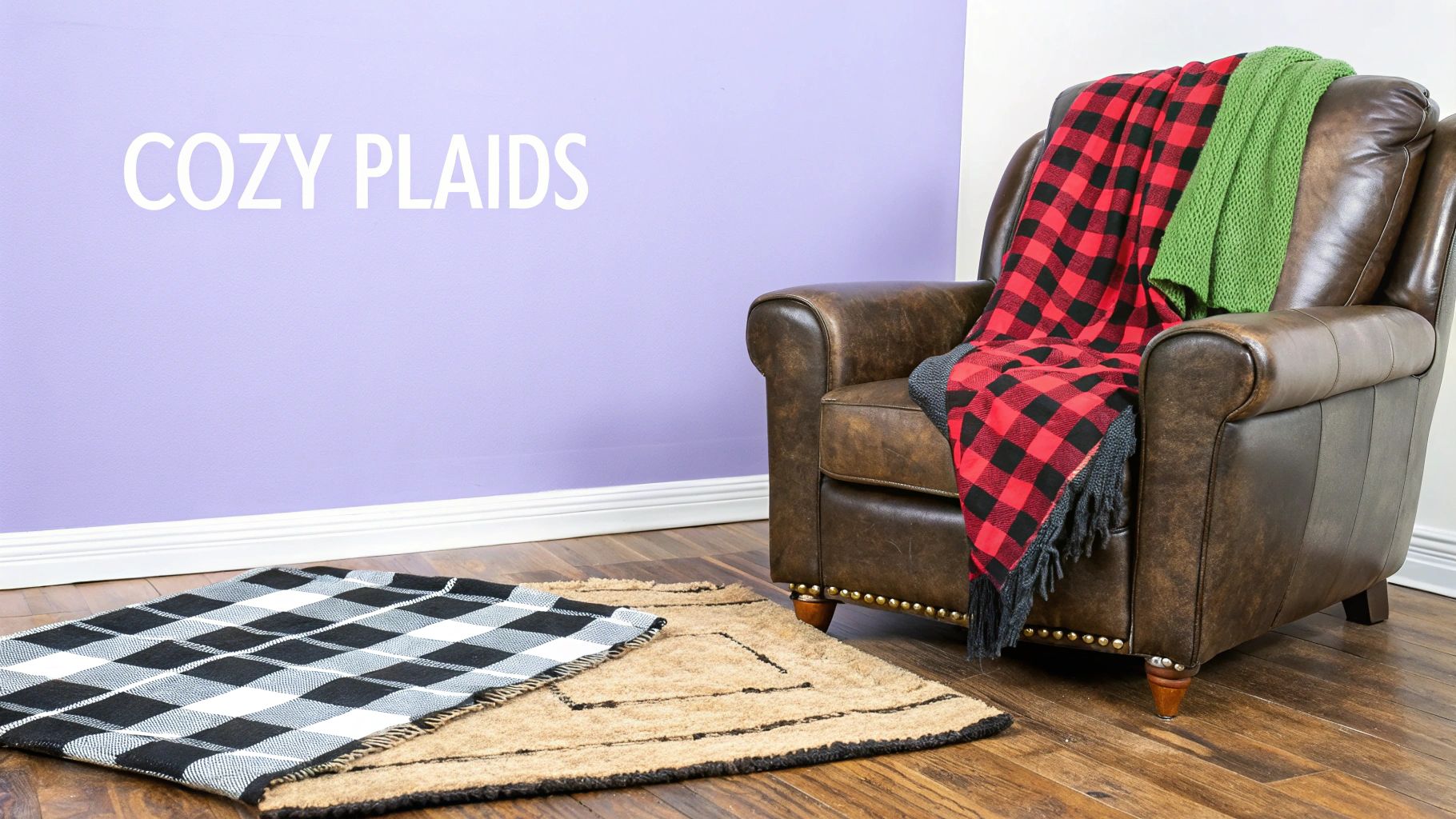
This method is ideal for those who appreciate the beauty in aged materials and want their space to feel collected rather than decorated all at once. For instance, pairing an antique farmhouse dining table with modern upholstered chairs or placing a vintage leather club chair next to a contemporary side table strikes a perfect balance. The key is to blend different eras and styles harmoniously, creating a space that feels both timeless and unique. You can find more inspiration on blending old with new in our guide to modern country decorating.
How to Implement a Vintage and Antique Mix
Achieving a cohesive look with furniture from different periods requires a thoughtful strategy. The goal is a curated collection, not a cluttered jumble.
- Establish a Unifying Colour Palette: Use a consistent colour scheme to tie disparate pieces together. Neutral wall colours can provide a calm backdrop that allows the unique shapes and textures of your furniture to stand out.
- Balance Ornate with Simple: To avoid an overwhelming or dated look, pair an intricate, ornate piece (like a carved Victorian armchair) with furniture that has simple, clean lines. This contrast creates visual harmony and allows each item to shine.
- Invest in Key Pieces: Prioritise quality for foundational items like a sofa, coffee table, or sideboard. Well-made antique or vintage furniture often features superior craftsmanship and materials that have stood the test of time.
- Hunt for Treasures: Explore flea markets, antique shops, estate sales, and online marketplaces to find unique items. These venues are goldmines for one-of-a-kind furniture and décor that add genuine character to your rustic living room.
5. Natural Fiber Textiles and Layered Rugs
Layering natural fibre textiles is fundamental to creating a cosy and inviting rustic living room. This technique involves using materials like jute, wool, linen, and cotton to introduce varied textures that enhance the room's warmth and comfort. Layering rugs, in particular, adds visual depth, helps to define different zones within an open-plan space, and grounds the furniture arrangement with a soft, tactile foundation.
This approach, popularised by brands like Pottery Barn and Magnolia Home, moves beyond a single floor covering to create a curated, collected feel. A classic example is placing a smaller, more decorative rug, such as a vintage kilim or a soft cowhide, over a larger, neutral jute or sisal rug. This not only adds a splash of colour or pattern but also makes the space feel more thoughtfully designed and personalised.
How to Implement Layered Textiles
Successfully layering textiles requires a good eye for texture, scale, and colour to avoid a cluttered look.
- Vary Textures and Sizes: The key to successful rug layering is contrast. Place a smaller, high-pile wool rug over a larger, low-pile jute rug to create a clear visual and tactile distinction. Ensure the top rug is significantly smaller to allow the base layer to frame it effectively.
- Establish a Cohesive Colour Palette: Choose a unifying colour that ties the different textiles together. Your throws, cushions, and layered rugs should share a common hue to create a harmonious and deliberate design scheme rather than a chaotic one.
- Use Rug Pads for Safety: Always place a non-slip rug pad under each layer, especially the top one. This prevents dangerous slipping and bunching, keeping the arrangement neat and secure in high-traffic areas.
- Mix Smooth and Textured Weaves: Extend the layering principle to your furniture. Drape a chunky-knit wool throw over a smooth leather sofa or add raw linen cushions to a fabric armchair to build layers of texture throughout the room.
6. Industrial Metal Accents
Incorporating industrial metal accents is an effective strategy for adding a layer of modern edge and material contrast to a rustic living room. This design choice involves integrating elements made from weathered or raw metals like iron, steel, and copper. When placed alongside natural wood and stone, these materials create a compelling dialogue between the raw and the refined, preventing the rustic aesthetic from feeling one-dimensional.
This blend of rustic and industrial styles, popularised by retailers like Restoration Hardware, works beautifully because both aesthetics celebrate raw, honest materials. A wrought-iron chandelier, steel-framed coffee table, or even simple metal pipe shelving can introduce a structural, contemporary feel that enhances the warmth of surrounding wood tones and soft textiles. This approach is ideal for creating a sophisticated yet unpretentious atmosphere.
How to Implement Industrial Metal Accents
Successfully integrating metal requires a considered approach to balance and scale. The goal is to create contrast without overwhelming the room's inherent cosiness.
- Create Balance: Pair cool, hard metals with warm, soft textures. For example, place a steel and wood coffee table on a plush, high-pile rug or position a sleek metal floor lamp next to a comfortable, fabric-upholstered armchair.
- Maintain Consistency: While mixing metals can be done artfully, sticking to one or two consistent finishes, such as matte black or brushed bronze, creates a more cohesive and organised look throughout the space.
- Consider Scale: Use metal in proportion to your room's size. Large, statement pieces like a big iron chandelier work well in rooms with high ceilings, whereas smaller accents like copper plant pots or metal-framed mirrors are better suited for more compact living areas.
- Start Small: If you're hesitant, introduce metal accents gradually. Begin with smaller decorative items like picture frames, curtain rods, or cabinet hardware to see how the material interacts with your existing décor.
7. Cozy Plaid and Check Patterns
Incorporating classic patterns like plaid, buffalo check, and gingham is a timeless strategy for infusing your rustic living room with a sense of homeliness and tradition. These textiles, used for pillows, throws, curtains, or even upholstery, instantly evoke the comforting aesthetic of a mountain lodge or a country cottage. The structured yet warm patterns add visual interest and a layer of texture that breaks up the dominance of wood and stone elements.
The appeal of these patterns, popularised by heritage brands like Ralph Lauren Home and Pendleton, lies in their ability to add colour and personality without compromising the rustic theme. A tartan plaid pillow on a neutral-toned sofa or a bold buffalo check throw draped over a leather armchair creates a welcoming focal point. This approach is perfect for achieving an authentic, lived-in feel that is both stylish and deeply comfortable.
How to Implement Plaid and Check Patterns
Successfully using these bold patterns is about balance and strategic placement. You want to add character, not overwhelm the space.
- Start Small with Accents: If you are new to using patterns, begin with smaller items. A few tartan cushions, a single large-scale check throw, or even plaid-trimmed lampshades can make a significant impact without a major commitment.
- Mix and Match Scales: Create visual depth by mixing patterns of different sizes. For example, pair a large buffalo check on an accent chair with smaller-scale gingham pillows on the sofa. This prevents the patterns from clashing and looking too busy.
- Balance with Solids: Ensure you have plenty of solid colours and neutral textures to ground the patterns. A bold plaid will stand out beautifully against a solid linen sofa, natural wood tones, or a simple jute rug. This balance is key to creating a cosy, inviting atmosphere. Learn more about making a room feel cosy with thoughtful textile choices.
- Consider Colour Palette: Choose plaids and checks that align with your room's existing colour scheme. Earthy tones like forest green, deep navy, and burgundy are classic choices that enhance the natural feel of a rustic interior.
8. Natural Wood Furniture
Natural wood furniture is the cornerstone of any authentic rustic living room, showcasing the raw, unrefined beauty of timber. This style celebrates pieces where the wood's inherent character, such as its grain, knots, and organic shapes, is the main feature. From live-edge tables that follow the natural contour of the tree to sturdy log furniture, these items bring an unparalleled sense of the outdoors inside, grounding your space in nature.
This approach is championed by custom artisans and sustainable furniture makers who prioritise quality and the story of the material. A reclaimed barn wood coffee table or a hand-hewn pine entertainment centre can serve as a functional work of art. These pieces are not just furniture; they are conversation starters that add timeless durability and warmth to your home's design scheme.
How to Implement Natural Wood Furniture
Choosing the right wood pieces involves more than just aesthetics; it's about creating a balanced and lasting environment.
- Balance is Essential: To avoid an overwhelming "log cabin" effect, balance heavy wood furniture with softer materials like plush upholstery, woven textiles, and sleek metal accents. A chunky wooden mantelpiece, for instance, pairs beautifully with a soft, neutral-coloured sofa.
- Invest in Quality: Natural wood furniture is an investment. Opt for well-crafted, solid wood pieces that are built to last. These will age gracefully, developing a richer patina over time and becoming heirloom items.
- Let the Wood Shine: Allow the wood's natural character to be the star. Choose simple, functional designs and avoid cluttering the surfaces. A protective matte or satin finish will safeguard the wood from spills and wear without masking its beautiful texture.
- Consider Regional Woods: Incorporating wood species native to your region, like oak, pine, or beech in the UK, adds a layer of local authenticity to your rustic living room design.
9. Vintage Lighting Fixtures
The right lighting does more than just illuminate a space; it sets the mood and acts as a centrepiece. Incorporating vintage or vintage-inspired lighting fixtures is an essential step in creating an authentic rustic living room. These pieces, from grand wrought iron chandeliers to subtle lantern-style pendants, introduce materials and forms that speak to a bygone era, adding layers of texture, history, and character to your design.
These fixtures are statement pieces that tie the entire room together. A dramatic antler chandelier can become the defining feature of a mountain lodge theme, while a series of Mason jar pendants or Edison bulb installations offers a softer, more industrial-farmhouse feel. This approach allows you to inject personality and a bespoke touch, whether you source genuine antiques or choose high-quality reproductions from artisans on Etsy or specialised retailers.
How to Implement Vintage Lighting
Choosing and installing the right vintage fixtures requires both aesthetic consideration and practical knowledge.
- Layer Your Lighting: Don't rely on a single overhead fixture. Combine a main chandelier with task lighting like reading lamps and ambient lighting such as wall sconces. This creates a functional and inviting atmosphere.
- Scale is Everything: Ensure the fixture's size is appropriate for your room. A massive wagon wheel chandelier can overwhelm a small space, while a tiny pendant will get lost under a vaulted ceiling. Measure your room's dimensions to find a balanced fit.
- Embrace Warmth: Opt for bulbs with a warm colour temperature (around 2700K). This amber-toned glow enhances the cosy, welcoming nature of rustic interiors, complementing natural materials like wood and stone.
- Control the Ambience: Installing dimmer switches is a simple yet highly effective upgrade. This gives you complete control over the light intensity, allowing you to transition from bright, functional lighting to a soft, intimate glow for relaxing evenings. For further inspiration, you can find a variety of lighting ideas for your home.
Rustic Living Room Elements Comparison
Bringing Your Rustic Vision to Life
Creating a captivating rustic living room is less about following a rigid set of rules and more about orchestrating a symphony of natural materials, historical character, and personal comfort. Throughout this guide, we've explored how distinct elements, from the foundational strength of a stone fireplace surround to the subtle charm of plaid textiles, work in harmony to build an authentic and inviting space. The journey is one of curation, where each piece contributes to a narrative of warmth, heritage, and connection to the natural world.
The most compelling rustic interiors feel as though they have evolved organically over time. They are a testament to the beauty found in imperfection. Whether you choose to introduce the architectural grandeur of exposed wooden beams or the quiet integrity of reclaimed wood accent walls, the goal remains the same: to create a sanctuary that feels both grounded and deeply personal. Mastering this balance is key to designing a space that is not just aesthetically pleasing but also a true haven for relaxation and connection.
Your Actionable Next Steps
Feeling inspired? The best way to begin is by focusing on one or two core elements that resonate most with you. Don't feel pressured to overhaul your entire space at once. A gradual approach often yields the most authentic results.
- Assess Your Foundation: Start by evaluating your room's existing architectural features. Do you have a fireplace that could be updated with a stone surround? Are your ceilings suitable for adding decorative (or exposing structural) beams? Identifying these opportunities provides a clear starting point.
- Prioritise a Focal Point: Select one major feature to be the hero of your rustic living room. This could be a dramatic reclaimed wood wall, a substantial piece of natural wood furniture like a coffee table, or a stunning vintage lighting fixture that commands attention. Build the rest of your design around this central element.
- Layer with Textiles and Accents: Once your foundational pieces are in place, introduce softness and personality. Begin layering with natural fibre rugs, add cosy throws in plaid or check patterns, and strategically place industrial metal accents like lamps or shelf brackets to introduce a modern, edgy contrast.
Remember, the ultimate goal is to craft a rustic living room that is a unique reflection of your own style. It’s about building a space where stories are shared, memories are made, and comfort is paramount. By thoughtfully combining rugged textures with soft, welcoming details, you will create more than just a well-decorated room; you will cultivate a home filled with character and warmth that you and your family will cherish for years to come.

